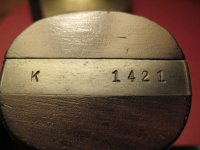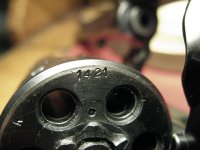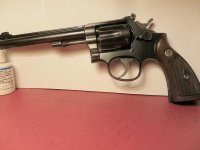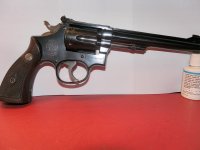I recently purchased a K-22 S&W revolver from a widow of a local gentleman who purchased the gun new when he returned from WWII. While looking the gun over more carefully after returning home I found that the matching numbers on the yoke and cylinder hinge were different from the other matching numbers ( K 1421) which were on the butt, underside of the barrel, on the cylinder, the ejector and on the inside of the right grip as if you were pointing the revolver. What gives with a combination of serial numbers? I had 2 more pictures but I reached the maximum of allowable pictures. You may also acknowledge me through my personal email which is [email protected] Thank you all in advance.
You are using an out of date browser. It may not display this or other websites correctly.
You should upgrade or use an alternative browser.
You should upgrade or use an alternative browser.
K-22 with two different serial numbers
- Thread starter flasks
- Start date
Register to hide this ad
The yoke and frame numbers are assembly numbers, to keep the fitted parts together in the factory. They have no meaning now.
Welcome to the forum !
Nice score !
Welcome to the forum !
Nice score !
Last edited:
Welcome to the Forum. All vintage S&W revolvers had assembly numbers or letters to identify major parts after fitting and before they went off for finishing. This assured that the finished parts would find their way back together. That number is meaningless once the gun is back together. No really good reason why the company did not use serial numbers for assembly that I can think of, besides there are serial numbers on most of the parts that have assembly numbers.
Looks like a nice first year Mastrpiece that would have shipped in 1947.
Looks like a nice first year Mastrpiece that would have shipped in 1947.
- Joined
- Aug 21, 2005
- Messages
- 7,994
- Reaction score
- 7,045
That revolver only has one serial number, the K1421. The yoke number is an assembly number, and means nothing. The official serial number for ATF purposes is on the frame (butt) and the barrel and cylinder match. Good show!
- Joined
- Jun 28, 2007
- Messages
- 27,660
- Reaction score
- 21,285
Welcome also! Here is a good post for information about SNs and other ID information:
http://smith-wessonforum.com/s-w-revolvers-1961-1980/332218-identify-your-gun.html
Your new K-22 Masterpiece was likely shipped in the middle of 1947, and is one of a few thousand post-war guns that had the "large ejector rod knob" or LERK. It certainly fits with the story of it being bought by a returning GI after WW II. Here are a few Forum posts about it:
http://smith-wessonforum.com/search...57862&cof=FORID:10&ie=UTF-8&q=K-22+LERK&sa=Go
Lastly, a letter of authenticity would be a nice addition to its history; it would tell you the exact day it left the factory and its destination, but it will not likely name the purchaser.
Smith & Wesson Historical Foundation - Letter Process - Insuring that the rich history of Smith & Wesson will continue for generations to come
Enjoy and treasure that one!
http://smith-wessonforum.com/s-w-revolvers-1961-1980/332218-identify-your-gun.html
Your new K-22 Masterpiece was likely shipped in the middle of 1947, and is one of a few thousand post-war guns that had the "large ejector rod knob" or LERK. It certainly fits with the story of it being bought by a returning GI after WW II. Here are a few Forum posts about it:
http://smith-wessonforum.com/search...57862&cof=FORID:10&ie=UTF-8&q=K-22+LERK&sa=Go
Lastly, a letter of authenticity would be a nice addition to its history; it would tell you the exact day it left the factory and its destination, but it will not likely name the purchaser.
Smith & Wesson Historical Foundation - Letter Process - Insuring that the rich history of Smith & Wesson will continue for generations to come
Enjoy and treasure that one!
- Joined
- Mar 17, 2005
- Messages
- 26,071
- Reaction score
- 48,186
Welcome to the Forum. All vintage S&W revolvers had assembly numbers or letters to identify major parts after fitting and before they went off for finishing. This assured that the finished parts would find their way back together. That number is meaningless once the gun is back together. No really good reason why the company did not use serial numbers for assembly that I can think of, besides there are serial numbers on most of the parts that have assembly numbers.
Companies don't usually pay people to do unnecessary jobs.
The simple answer is that frames did not yet have a serial number when yokes and sideplates were fitted in the hand ejector era, so an assembly number was used to keep those three parts together.
That MIGHT be because some frames could be scrapped in the process, and that would have left a gap in the serial number sequence.
The serial number on the yoke does seem redundant. I can't think of a good explanation for it since the yoke already had an assembly number matching it to the frame.
flasks
It appears that you have a pretty nice and very early K-22 Masterpiece. The presence of the "fat" extractor rod knob makes this one particularly desirable. Please do post pictures of the whole gun showing both sides (you can post more photos in a subsequent post). As stated by others, this one was made in 1947. Wonderful find!
It appears that you have a pretty nice and very early K-22 Masterpiece. The presence of the "fat" extractor rod knob makes this one particularly desirable. Please do post pictures of the whole gun showing both sides (you can post more photos in a subsequent post). As stated by others, this one was made in 1947. Wonderful find!
. . . The simple answer is that frames did not yet have a serial number when yokes and sideplates were fitted in the hand ejector era . . . MIGHT be because some frames could be scrapped in the process, and that would have left a gap in the serial number sequence . . .
Interesting possibility, but I doubt that there would be but a handful in a year that might be rejected. We all know there are gaps in most serial number lists already and the company did not ship in serial number order, so it would have made little difference whether a rare scraped gun would be missing from the list from time to time.
After all, it would be an easy way to determine the frequency of faulty parts manufactured and give those quality control folks some statistics to play with.
Green Frog
Member
To the OP: welcome to the S&W Forum. As you have already seen, you can learn a whole lot about S&Ws very quickly here and hear both facts and opinions about these guns that can probably be found nowhere else (at least not in this concentrated form!)
Early post-War revolvers like yours have inspired a great deal of interest and discussion here over the years and if you wish to take the time to just browse (or do an organized search using that feature) you will be able to find more information than you would even dream about. My guess is that unless you are going to do an in-depth study of this particular gun, the information that will be added to what you find here through the purchase of a "factory letter" will be limited to date shipped and company or business to which it was shipped. You can already be pretty sure it never passed through famous hands or had any other historical connection that would come to light from a letter. Other information in the letter would be things like original sights, finish and stocks (grips) which in your case are pretty obvious, I would guess.
Anyway, congratulations on acquiring a most desirable S&W and enjoy shooting and just owning this piece of the company's finest work from the classic post-War era.
Froggie
Early post-War revolvers like yours have inspired a great deal of interest and discussion here over the years and if you wish to take the time to just browse (or do an organized search using that feature) you will be able to find more information than you would even dream about. My guess is that unless you are going to do an in-depth study of this particular gun, the information that will be added to what you find here through the purchase of a "factory letter" will be limited to date shipped and company or business to which it was shipped. You can already be pretty sure it never passed through famous hands or had any other historical connection that would come to light from a letter. Other information in the letter would be things like original sights, finish and stocks (grips) which in your case are pretty obvious, I would guess.
Anyway, congratulations on acquiring a most desirable S&W and enjoy shooting and just owning this piece of the company's finest work from the classic post-War era.
Froggie
Thanks your information. This small town where the WW11 vet lived had only one large hunting/fishing store named "Hoppes", pronounced the same as the gun cleaning fluid. This store maintained a large stock of firearms starting about 1935 and likely the revolver was purchased there. I want to add this gun to my firearms insurance rider policy but need a professional collector like yourself to give me a reasonable value. Thank you very much.
So where is your crystal ball to tell the OP that his gun didn't pass through famous hands?the information that will be added to what you find here through the purchase of a "factory letter" will be limited to date shipped and company or business to which it was shipped. You can already be pretty sure it never passed through famous hands or had any other historical connection that would come to light from a letter. Other information in the letter would be things like original sights, finish and stocks (grips) which in your case are pretty obvious, I would guess.
Froggie
Don Mundell
Assistant Historian
Smith & Wesson Historical Foundation
Crystal ball tells me I knew the man...we're both 80, he's deceased now but his wife remembers him buying it locally and that's how I know where it was purchased. Your comment was not appreciated and uncalled for. I'm not savvy like yourself so you can tell me what "OP" means. If you're a historian you should act like one.
Very much appreciate the comments regarding what I thought were two serial numbers..rather learned these are assembly number. I was requested to add pictures of the entire gun so here they are.
That's one of the nicer examples a person will see. Congratulations.
Engine49guy
Member
Very nice K-22 with one line Made In USA address and large ejector rod knob.
K-22 collectors are hot for early post war examples so there is a slight premium for the early guns, For insurance purposes I would guess in the $1000-$1500 range, if you have the original box, docs and tools perhaps a bit more .
As for the the later practice of stamping the serial in the yoke cut being redundant Im assuming as the factory phased out the barrel and cylinder serial stamp and as factory target stocks (which cover the heel serial stamp) began to increase in popularity perhaps it was realized it not only saved time to quickly access the serial without having to remove the stocks but may have also prevented naive dealers or the lay person from accidentally recording the assembly numbers in the yoke as the handguns serial number preventing people from unknowingly breaking the law.
Again that is just my assumption but consider as supporting evidence that both my Model 66 and 66-1 snubs do not have a serial stamped in the yoke, (Im guessing snub 19-2 - 19-3 and maybe 19-4's would be the same way).
This could suggest the step of stamping a serial in the yoke was thought unnecessary since factory Magna stocks (at the time) did not obscure the heel serial stamp, At some point snubs did get the serial stamp in the yoke cut ,
Im assuming that might have had something to do with the fact that S&W began offering RB factory target and Combat stocks for K snubs that covered the heel serial.
K-22 collectors are hot for early post war examples so there is a slight premium for the early guns, For insurance purposes I would guess in the $1000-$1500 range, if you have the original box, docs and tools perhaps a bit more .
As for the the later practice of stamping the serial in the yoke cut being redundant Im assuming as the factory phased out the barrel and cylinder serial stamp and as factory target stocks (which cover the heel serial stamp) began to increase in popularity perhaps it was realized it not only saved time to quickly access the serial without having to remove the stocks but may have also prevented naive dealers or the lay person from accidentally recording the assembly numbers in the yoke as the handguns serial number preventing people from unknowingly breaking the law.
Again that is just my assumption but consider as supporting evidence that both my Model 66 and 66-1 snubs do not have a serial stamped in the yoke, (Im guessing snub 19-2 - 19-3 and maybe 19-4's would be the same way).
This could suggest the step of stamping a serial in the yoke was thought unnecessary since factory Magna stocks (at the time) did not obscure the heel serial stamp, At some point snubs did get the serial stamp in the yoke cut ,
Im assuming that might have had something to do with the fact that S&W began offering RB factory target and Combat stocks for K snubs that covered the heel serial.
Last edited:
Crystal ball tells me I knew the man...we're both 80, he's deceased now but his wife remembers him buying it locally and that's how I know where it was purchased. Your comment was not appreciated and uncalled for. I'm not savvy like yourself so you can tell me what "OP" means. If you're a historian you should act like one.
If I offened you, I'm sorry my comment wasn't directed at you, but, I don't think you know where the gun was purchased. you can just guess away. Enjoy it.
Green Frog
Member
So where is your crystal ball to tell the OP that his gun didn't pass through famous hands?
Don Mundell
Assistant Historian
Smith & Wesson Historical Foundation
Doesn't take a crystal ball, just a little deductive reasoning. The OP (original poster) mentioned that it was a one owner gun, purchased new by a returning vet whose widow sold it to him (the OP.) He would probably know if the vet had been famous.
Sorry if I offended your sensibilities or insulted the letter process Don, but if you have interesting information you wish to share with the new member, better to do that than to berate me for my reasonable assumption. Otherwise, I stand by my opinion.
With utmost respect,
Green Frog
- Joined
- Jun 28, 2007
- Messages
- 27,660
- Reaction score
- 21,285
I think you could safely put an insurance value of $1200 on it.
Similar threads
- Replies
- 6
- Views
- 179
- Replies
- 17
- Views
- 887
- Replies
- 6
- Views
- 705
- Replies
- 4
- Views
- 389









